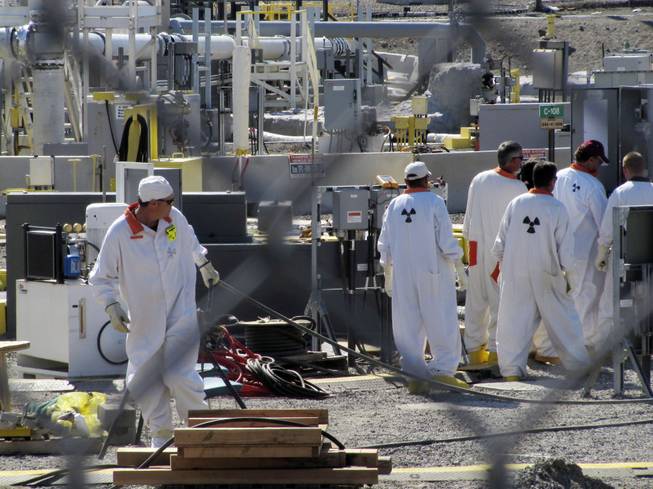
Shannon Dininny / AP
In this July 14, 2010, photo, workers at the Hanford nuclear reservation work around a a tank farm where highly radioactive waste is stored underground near Richland, Wash.
Friday, Feb. 28, 2014 | 5:45 p.m.
SPOKANE, Wash. — There are "significant construction flaws" in some newer, double-walled storage tanks at Washington state's Hanford nuclear waste complex, which could lead to additional leaks, according to documents obtained by The Associated Press.
Those tanks hold some of the worst radioactive waste at the nation's most contaminated nuclear site.
One of the 28 giant underground tanks was found to be leaking in 2012. But subsequent surveys of other double-walled tanks performed for the U.S. Department of Energy by one of its Hanford contractors found at least six shared defects with the leaking tank that could lead to future leaks, the documents said. Thirteen additional tanks also might be compromised, according to the documents.
Questions about the storage tanks jeopardize efforts to clean up radioactive waste at the southeastern Washington site. Those efforts already cost taxpayers about $2 billion a year.
"It is time for the Department (of Energy) to stop hiding the ball and pretending that the situation at Hanford is being effectively managed," Sen. Ron Wyden, D-Ore., wrote Friday in a letter to Energy Secretary Ernest Moniz.
Energy Department officials in Richland said the agency continues to make thorough inspections of the tanks, and has increased the frequency of those inspections.
"They used to be reviewed every five to seven years," said Tom Fletcher, the Energy Department's assistant manager for tank farms. "Now we are moving to a three-year time frame."
The department is in the process of inspecting the final eight double-walled tanks at Hanford that have not been analyzed since the leak was detected in late 2012, Fletcher said Friday.
No new leaks have been found, he said.
"If there are changes or improvements we need to make in the program, based on what we learn, to make sure we capture the risks that exist on the tank farms, we will make them," Fletcher said.
He added the Energy Department continues to examine the benefits of building new storage tanks at Hanford.
Tom Carpenter of the citizen watchdog group Hanford Challenge said he wasn't surprised that more of the double-walled tanks are in danger of leaking.
"These tanks have an engineered design life, and we are reaching the end," Carpenter said. "It's bad planning that they don't have new tanks up and running."
While new tanks are expensive, cleaning up a leak is more expensive, he added. "The price for cleaning up the environment once this stuff gets out there is incalculable."
Hanford contains some 53 million gallons of high-level radioactive wastes from the production of plutonium for nuclear weapons. They are stored in 177 underground storage tanks, many of which date back to World War II and are single-walled models that have leaked. The 28 double-walled tanks were built from the 1960s to the 1980s.
Current plans call for transferring wastes from leaking single-walled tanks to the newer and bigger double-walled tanks, where the waste will be stored while a $13 billion plant for treating the waste is constructed. But the treatment plant is plagued with design problems and construction has stalled.
The situation did not appear dire until the news in October 2012 that the oldest of the double-walled tanks, called AY-102, had leaked, becoming the first of those 28 tanks to do so.
At the time, the Energy Department blamed construction problems with this particular tank for the leak and said it "seems unlikely" that the other double-walled tanks would leak.
However, Wyden said engineering reviews of six other double-walled tanks "found significant construction flaws in those six tanks essentially similar to those at the leaking tank." Those six tanks contain about 5 million gallons of radioactive wastes, wrote Wyden, who until recently was chairman of the Senate Energy and Natural Resources Committee.
For instance, one tank was found to have bulging "in the primary and secondary bottoms," according to the documents obtained through Wyden's office. The tank also had a high number of welds that were rejected by inspectors and done again during its construction.
Additionally, a review of 13 other double-walled tanks found they were in better shape than the leaker. "But construction issues identified for these tanks, such as weld rejection rates, are cause for concern" and raise "uncertainty of long-term tank integrity," Wyden wrote.
That means that 20 of the 28 double-walled tanks at Hanford raise some level of concern.
Wyden said the Energy Department should take a new look at proposals by the governors of Washington and Oregon to build new storage tanks at Hanford. Such tanks are likely to cost more than $100 million each.
The senator also criticized the Energy Department for releasing a "framework" for the cleanup of Hanford in September that did not mention the construction flaws in the double-walled tanks. He called that "indefensible."
"The citizens living along banks of the Columbia River deserve to know the full story of what is happening with the Hanford tanks," Wyden wrote.
Wyden asked the Energy Department to respond with an action plan in 45 days.
Hanford, located near Richland, stores about two-thirds of the nation's high-level radioactive waste.
Officials have said the leaking materials pose no immediate risk to public safety or the environment because it would take perhaps years for the chemicals to reach groundwater.
The federal government built Hanford at the height of World War II as part of the Manhattan Project to build the atomic bomb.

Join the Discussion:
Check this out for a full explanation of our conversion to the LiveFyre commenting system and instructions on how to sign up for an account.
Full comments policy